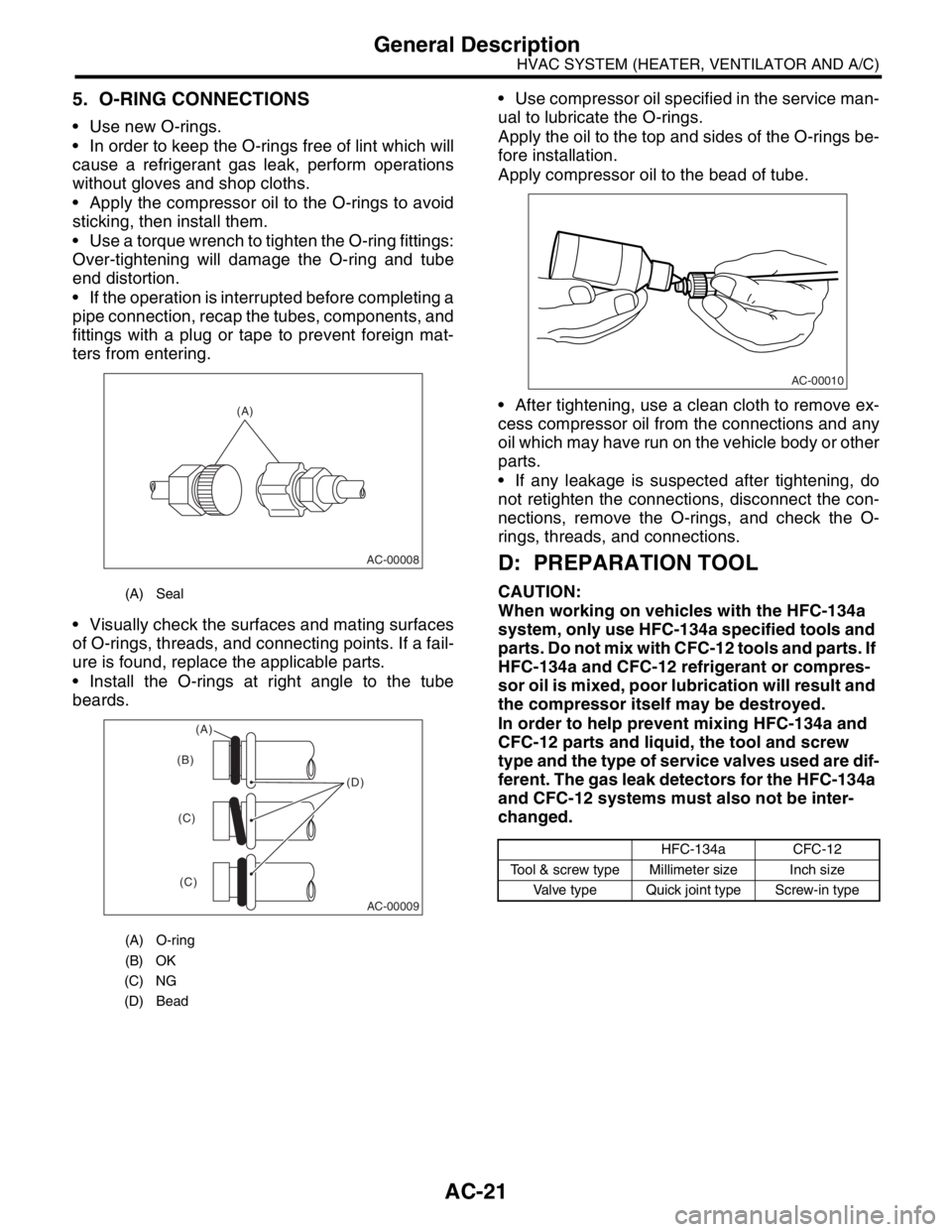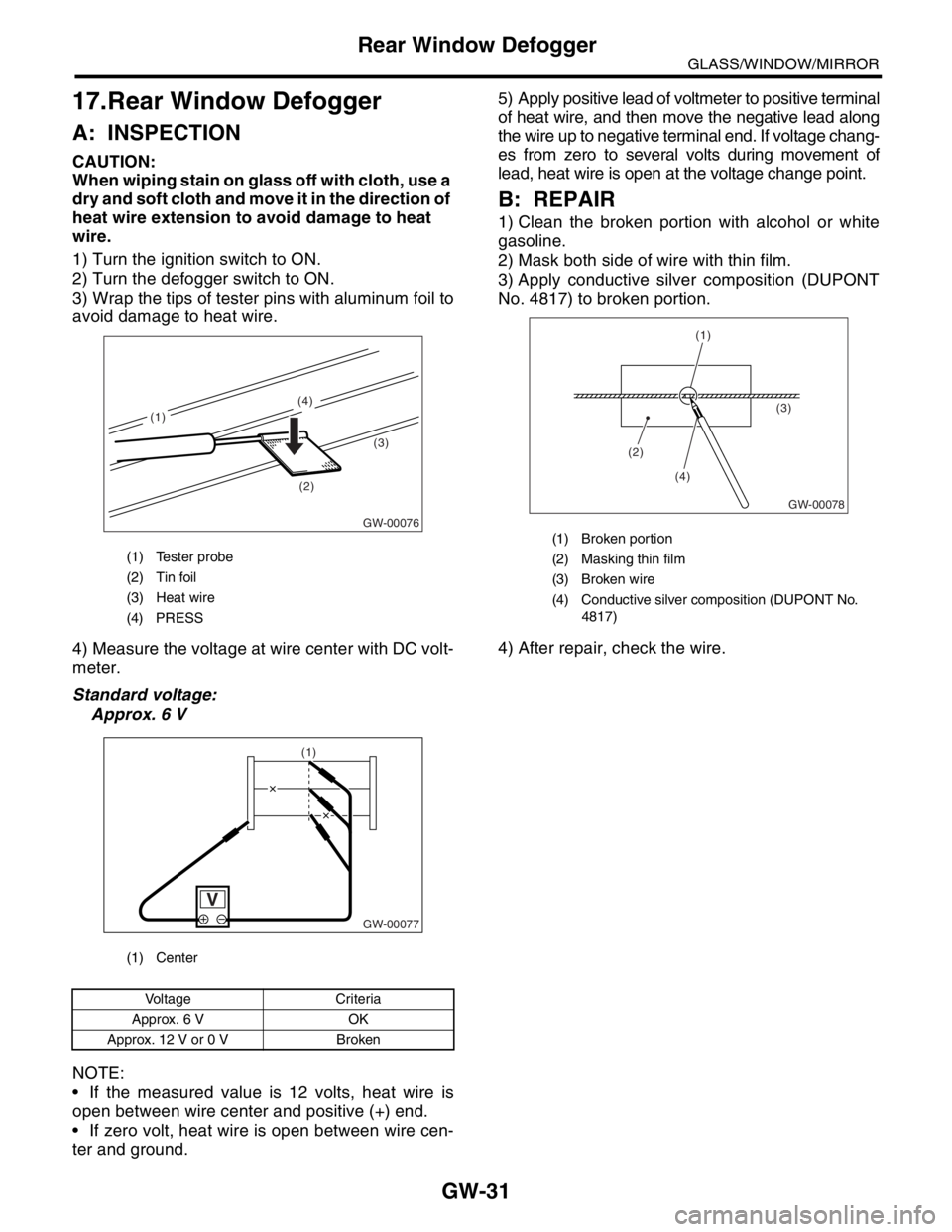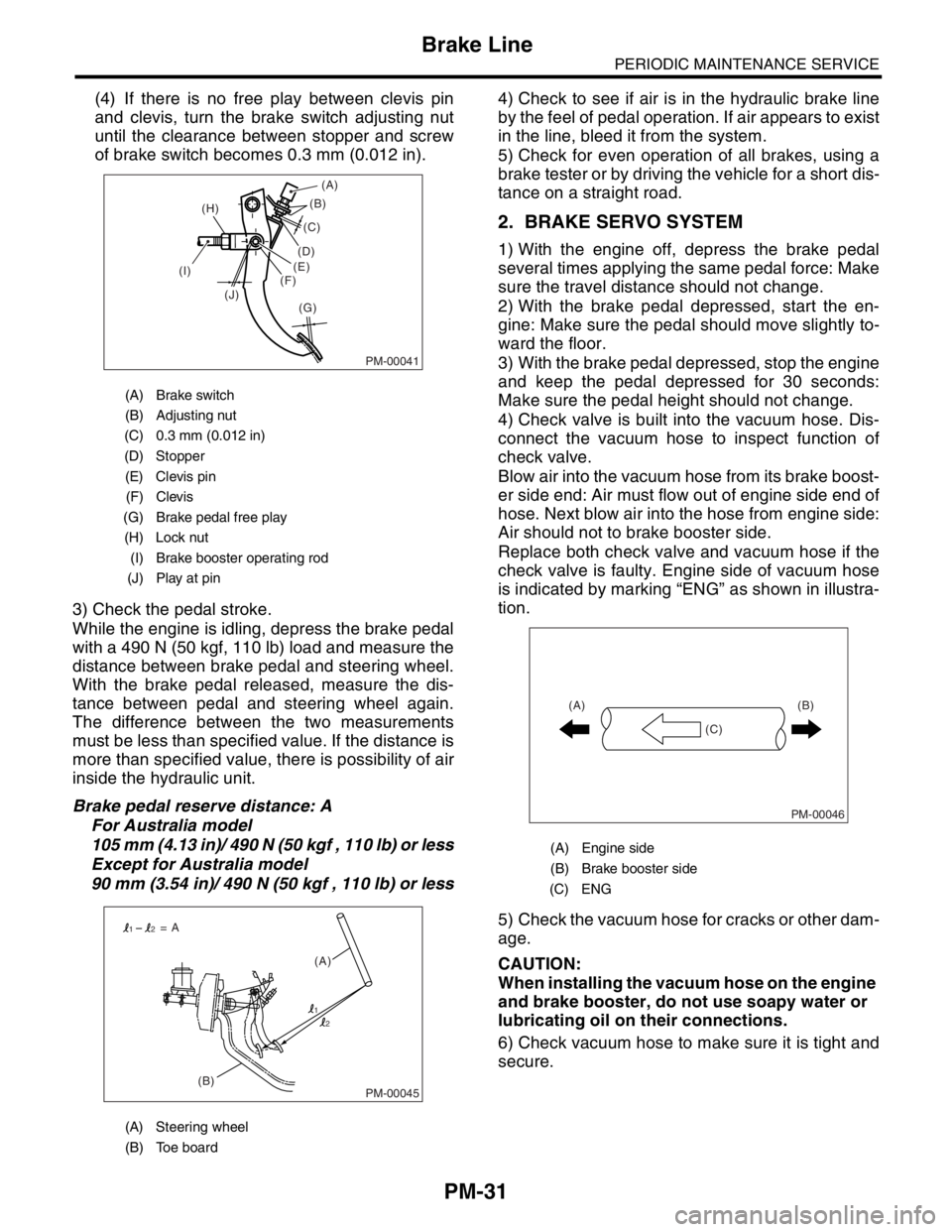2004 SUBARU FORESTER oil change
[x] Cancel search: oil changePage 23 of 2870

AC-21
HVAC SYSTEM (HEATER, VENTILATOR AND A/C)
General Description
5. O-RING CONNECTIONS
Use new O-rings.
In order to keep the O-rings free of lint which will
cause a refrigerant gas leak, perform operations
without gloves and shop cloths.
Apply the compressor oil to the O-rings to avoid
sticking, then install them.
Use a torque wrench to tighten the O-ring fittings:
Over-tightening will damage the O-ring and tube
end distortion.
If the operation is interrupted before completing a
pipe connection, recap the tubes, components, and
fittings with a plug or tape to prevent foreign mat-
ters from entering.
Visually check the surfaces and mating surfaces
of O-rings, threads, and connecting points. If a fail-
ure is found, replace the applicable parts.
Install the O-rings at right angle to the tube
beards. Use compressor oil specified in the service man-
ual to lubricate the O-rings.
Apply the oil to the top and sides of the O-rings be-
fore installation.
Apply compressor oil to the bead of tube.
After tightening, use a clean cloth to remove ex-
cess compressor oil from the connections and any
oil which may have run on the vehicle body or other
parts.
If any leakage is suspected after tightening, do
not retighten the connections, disconnect the con-
nections, remove the O-rings, and check the O-
rings, threads, and connections.
D: PREPARATION TOOL
CAUTION:
When working on vehicles with the HFC-134a
system, only use HFC-134a specified tools and
parts. Do not mix with CFC-12 tools and parts. If
HFC-134a and CFC-12 refrigerant or compres-
sor oil is mixed, poor lubrication will result and
the compressor itself may be destroyed.
In order to help prevent mixing HFC-134a and
CFC-12 parts and liquid, the tool and screw
type and the type of service valves used are dif-
ferent. The gas leak detectors for the HFC-134a
and CFC-12 systems must also not be inter-
changed.(A) Seal
(A) O-ring
(B) OK
(C) NG
(D) Bead
(A)
AC-00008
AC-00009
(D) (B)
(C)
(C)
(A)
HFC-134a CFC-12
Tool & screw type Millimeter size Inch size
Valve type Quick joint type Screw-in type
AC-00010
Page 361 of 2870

GW-31
GLASS/WINDOW/MIRROR
Rear Window Defogger
17.Rear Window Defogger
A: INSPECTION
CAUTION:
When wiping stain on glass off with cloth, use a
dry and soft cloth and move it in the direction of
heat wire extension to avoid damage to heat
wire.
1) Turn the ignition switch to ON.
2) Turn the defogger switch to ON.
3) Wrap the tips of tester pins with aluminum foil to
avoid damage to heat wire.
4) Measure the voltage at wire center with DC volt-
meter.
Standard voltage:
Approx. 6 V
NOTE:
If the measured value is 12 volts, heat wire is
open between wire center and positive (+) end.
If zero volt, heat wire is open between wire cen-
ter and ground. 5) Apply positive lead of voltmeter to positive terminal
of heat wire, and then move the negative lead along
the wire up to negative terminal end. If voltage chang-
es from zero to several volts during movement of
lead, heat wire is open at the voltage change point.
B: REPAIR
1) Clean the broken portion with alcohol or white
gasoline.
2) Mask both side of wire with thin film.
3) Apply conductive silver composition (DUPONT
No. 4817) to broken portion.
4) After repair, check the wire.
(1) Tester probe
(2) Tin foil
(3) Heat wire
(4) PRESS
(1) Center
Voltage Criteria
Approx. 6 V OK
Approx. 12 V or 0 V Broken
GW-00076
(2)(3) (4)
(1)
GW-00077
(1)
(1) Broken portion
(2) Masking thin film
(3) Broken wire
(4) Conductive silver composition (DUPONT No.
4817)
GW-00078
(2)(3)
(4)
(1)
Page 768 of 2870

PM-31
PERIODIC MAINTENANCE SERVICE
Brake Line
(4) If there is no free play between clevis pin
and clevis, turn the brake switch adjusting nut
until the clearance between stopper and screw
of brake switch becomes 0.3 mm (0.012 in).
3) Check the pedal stroke.
While the engine is idling, depress the brake pedal
with a 490 N (50 kgf, 110 lb) load and measure the
distance between brake pedal and steering wheel.
With the brake pedal released, measure the dis-
tance between pedal and steering wheel again.
The difference between the two measurements
must be less than specified value. If the distance is
more than specified value, there is possibility of air
inside the hydraulic unit.
Brake pedal reserve distance: A
For Australia model
105 mm (4.13 in)/ 490 N (50 kgf , 110 lb) or less
Except for Australia model
90 mm (3.54 in)/ 490 N (50 kgf , 110 lb) or less4) Check to see if air is in the hydraulic brake line
by the feel of pedal operation. If air appears to exist
in the line, bleed it from the system.
5) Check for even operation of all brakes, using a
brake tester or by driving the vehicle for a short dis-
tance on a straight road.
2. BRAKE SERVO SYSTEM
1) With the engine off, depress the brake pedal
several times applying the same pedal force: Make
sure the travel distance should not change.
2) With the brake pedal depressed, start the en-
gine: Make sure the pedal should move slightly to-
ward the floor.
3) With the brake pedal depressed, stop the engine
and keep the pedal depressed for 30 seconds:
Make sure the pedal height should not change.
4) Check valve is built into the vacuum hose. Dis-
connect the vacuum hose to inspect function of
check valve.
Blow air into the vacuum hose from its brake boost-
er side end: Air must flow out of engine side end of
hose. Next blow air into the hose from engine side:
Air should not to brake booster side.
Replace both check valve and vacuum hose if the
check valve is faulty. Engine side of vacuum hose
is indicated by marking “ENG” as shown in illustra-
tion.
5) Check the vacuum hose for cracks or other dam-
age.
CAUTION:
When installing the vacuum hose on the engine
and brake booster, do not use soapy water or
lubricating oil on their connections.
6) Check vacuum hose to make sure it is tight and
secure.
(A) Brake switch
(B) Adjusting nut
(C) 0.3 mm (0.012 in)
(D) Stopper
(E) Clevis pin
(F) Clevis
(G) Brake pedal free play
(H) Lock nut
(I) Brake booster operating rod
(J) Play at pin
(A) Steering wheel
(B) Toe board
PM-00041
(B)
(G) (H)
(I)
(J)(C)
(D)
(E)
(F)(A)
PM-00045(B)(A) = A
1
12
2
(A) Engine side
(B) Brake booster side
(C) ENG
PM-00046
(B)
(C) (A)
Page 1816 of 2870

EN(H4DOTC)-183
ENGINE (DIAGNOSTIC)
Diagnostic Procedure with Diagnostic Trouble Code (DTC)
Step Check Yes No
1 CHECK CURRENT DATA.
1) Start the engine.
2) Drive the vehicle at the speed of approx. 30
km/h (19 MPH), and then measure the ignition
timing advance angle using Subaru Select
Monitor or OBD-II general scan tool.
N
OTE:
Subaru Select Monitor
For detailed operation procedure, refer to
“READ CURRENT DATA SHOWN ON DIS-
PLAY FOR ENGINE”.
OBD-II general scan tool
For detailed operation procedures, refer to the
OBD-II General Scan Tool Operation Manual.Does the ignition timing
advance angle changed
smoothly according to engine
output?
Idling: −2 — +2°
Driving: −2 — +50°Repair the poor
contact connector.
N
OTE:
In this case, repair
the following:
Poor contact of
AVCS camshaft
position sensor
connector.
Poor contact in
ECM connector.Go to step 2.
2 CHECK HARNESS BETWEEN AVCS CAM-
SHAFT POSITION SENSOR CONNECTOR
AND ECM CONNECTOR.
1) Turn the ignition switch to OFF.
2) Disconnect the connector from AVCS cam-
shaft position sensor connector and ECM.
3) Measure the resistance of harness
between AVCS camshaft position sensor con-
nector and engine ground.
Connector & terminal
(B36) No. 1 — (B135) No. 21:
(B36) No. 2 — (B135) No. 29:Is the resistance less than 1
Ω?Go to step 3.Repair the har-
ness and connec-
tor.
N
OTE:
In this case, repair
the following:
Open circuit in
harness between
AVCS camshaft
position sensor
connector and
ECM connector
Poor contact in
ECM connector
Poor contact in
coupling connector
3 CHECK HARNESS BETWEEN AVCS CAM-
SHAFT POSITION SENSOR CONNECTOR
AND ECM CONNECTOR.
Measure the resistance of harness between
AVCS camshaft position sensor connector and
engine ground.
Connector & terminal
(E36) No. 1 — Engine ground:
(E36) No. 2 — Engine ground:Is the resistance more than 1
MΩ?Go to step 4.Repair the ground
short circuit in har-
ness between
AVCS camshaft
position sensor
connector and
ECM connector.
NOTE:
The harness be-
tween both con-
nectors are
shielded.Repair
ground short circuit
in harness togeth-
er with shield.
4 CHECK CONDITION OF AVCS CAMSHAFT
POSITION SENSOR CONNECTOR.Is the AVCS camshaft position
sensor connector installation
bolt tightened securely?Go to step 5.Tighten the AVCS
camshaft position
sensor connector
installation bolt
securely.
5 CHECK AVCS CAMSHAFT POSITION SEN-
SOR CONNECTOR.
1) Remove the AVCS camshaft position sen-
sor.
2) Measure the resistance between the AVCS
camshaft position sensor connector terminals.
Te r m i n a l s
No. 1 — No. 2:Is the resistance 1 — 4 kΩ? Check for the clog-
ging on oil pres-
sure routing of oil
flow control sole-
noid valve.Replace the AVCS
camshaft position
sensor connector.
AVCS Camshaft
Position Sensor.>
Page 1818 of 2870

EN(H4DOTC)-185
ENGINE (DIAGNOSTIC)
Diagnostic Procedure with Diagnostic Trouble Code (DTC)
Step Check Yes No
1 CHECK CURRENT DATA.
1) Start the engine.
2) Drive the vehicle at the speed of approx. 30
km/h (19 MPH), and then measure the ignition
timing advance angle using Subaru Select
Monitor or OBD-II general scan tool.
N
OTE:
Subaru Select Monitor
For detailed operation procedure, refer to
“READ CURRENT DATA SHOWN ON DIS-
PLAY FOR ENGINE”.
OBD-II general scan tool
For detailed operation procedures, refer to the
OBD-II General Scan Tool Operation Manual.Does the ignition timing
advance angle changed
smoothly according to engine
output?
Idling: −2 — +2°
Driving: −2 — +50°Repair the poor
contact connector.
N
OTE:
In this case, repair
the following:
Poor contact of
AVCS camshaft
position sensor
connector.
Poor contact in
ECM connector.Go to step 2.
2 CHECK HARNESS BETWEEN AVCS CAM-
SHAFT POSITION SENSOR CONNECTOR
AND ECM CONNECTOR.
1) Turn the ignition switch to OFF.
2) Disconnect the connector from AVCS cam-
shaft position sensor connector and ECM.
3) Measure the resistance of harness
between AVCS camshaft position sensor con-
nector and engine ground.
Connector & terminal
(B35) No. 1 — (B135) No. 20:
(B35) No. 2 — (B135) No. 28:Is the resistance less than 1
Ω?Go to step 3.Repair the har-
ness and connec-
tor.
N
OTE:
In this case, repair
the following:
Open circuit in
harness between
AVCS camshaft
position sensor
connector and
ECM connector
Poor contact in
ECM connector.
Poor contact in
coupling connector
3 CHECK HARNESS BETWEEN AVCS CAM-
SHAFT POSITION SENSOR CONNECTOR
AND ECM CONNECTOR.
Measure the resistance of harness between
AVCS camshaft position sensor connector and
engine ground.
Connector & terminal
(E35) No. 1 — Engine ground:
(E35) No. 2 — Engine ground:Is the resistance more than 1
MΩ?Go to step 4.Repair the ground
short circuit in har-
ness between
AVCS camshaft
position sensor
connector and
ECM connector.
NOTE:
The harness be-
tween both con-
nectors are
shielded.Repair
ground short circuit
in harness togeth-
er with shield.
4 CHECK CONDITION OF AVCS CAMSHAFT
POSITION SENSOR CONNECTOR.Is the AVCS camshaft position
sensor connector installation
bolt tightened securely?Go to step 5.Tighten the AVCS
camshaft position
sensor connector
installation bolt
securely.
5 CHECK AVCS CAMSHAFT POSITION SEN-
SOR CONNECTOR.
1) Remove the AVCS camshaft position sen-
sor connector.
2) Measure the resistance between the AVCS
camshaft position sensor connector terminals.
Te r m i n a l s
No. 1 — No. 2:Is the resistance 1 — 4 kΩ? Check for the oil
clogging on oil
pressure routing of
oil flow control
solenoid valve.Replace the AVCS
camshaft position
sensor connector.
AVCS Camshaft
Position Sensor.>
Page 2315 of 2870

4AT-3
AUTOMATIC TRANSMISSION
General Description
6. SELECTOR POSITION
7. HYDRAULIC CONTROL AND LUBRICA-
TION
8. COOLING AND HARNESS9. TRANSFER
P (Park)Transmission in neutral, output member immov-
able, and engine start possible
R
(Reverse)Transmission in reverse
N (Neu-
tral)Transmission in neutral and engine start possi-
ble
D (Drive)Automatic gear change 1st
←
→ 2nd ←
→ 3rd ←
→
4th
3 (3rd)Automatic gear change 1st
←
→ 2nd ←
→ 3rd ←
4th
2 (2nd)Automatic gear change 1st
←
→ 2nd ← 3rd ←
4th
1 (1st)1st gear locked (Deceleration possible 1st ←
2nd ← 3rd ← 4th)
Control
methodWire cable type
Ty p eElectronic/hydraulic control
[Four forward speed
changes by electrical signals
of vehicle speed and accel-
erator (throttle) opening]
FluidDEXRON III type automatic
transmission fluid
Fluid capac-
ity2.0 L Non-
turbo model8.4 — 8.72 (8.9 — 9.2 US
qt, 7.4 — 7.7 Imp qt)
Except for
2.0 L Non-
turbo model9.3 — 9.62 (9.8 — 10.1 US
qt, 8.2 — 8.4 Imp qt)
Lubrication systemForced feed lubrication with
oil pump
OilAutomatic transmission fluid
(above mentioned)
Cooling SystemLiquid-cooled cooler incorpo-
rated in radiator
Inhibitor switch 12 poles
Transmission harness 20 poles
Model2.0 L Non-
turbo2.5 L Non-
turboTu r b o
Transfer
typeMulti-plate transfer (MPT)
Drive &
driven plate
number of
transfer
clutch456
Control
methodElectronic, hydraulic type
LubricantThe same Automatic transmission fluid used
in automatic transmission
Reduction
gear ratio1.000 (53/53)
Page 2344 of 2870

4AT-32
AUTOMATIC TRANSMISSION
Road Test
4. Road Test
A: INSPECTION
1. GENERAL PRECAUTION
Road tests should be conducted to properly diag-
nose the condition of the automatic transmission.
NOTE:
When performing the test, do not exceed posted
speed limit.
2. D RANGE SHIFT FUNCTION
Check shifting between 1st ←→ 2nd ←→ 3rd ←→
4th while driving on normal city streets.
3. D RANGE SHIFT SHOCK
Check the shock level when shifting up during nor-
mal driving.
4. KICK-DOWN FUNCTION
Check kick-down for each gear. Also check the
kick-down shock level.
5. ENGINE BRAKE OPERATION
Check the 3rd gear engine brake when shifting
down from D ←→ 3rd range while driving in 4th
gear of D range [50 — 60 km/h (31 — 37 MPH)].
Check the 2nd gear engine brake when shifting
between 3rd ←→ 2nd range while driving in the 3rd
range of 3rd gear [40 — 50 km/h (25 — 31 MPH)].
Check the 1st gear engine brake when shifting
between 2nd ←→ 1st range while driving in the 2nd
range of 2nd gear [20 — 30 km/h (12 — 19 MPH)].
6. LOCK-UP FUNCTION
Check that rpm does not change sharply when
the axle pedal is lightly depressed when driving on
flat roads at 60 km/h (37 MPH).
Check slip lock-up with following procedure.
Subaru Select Monitor is needed for checking (EC,
EK model).
Before start checking, check that the DTC is not ex-
isted using Subaru Select Monitor. When the DTC
is existed, perform the collective action with DTC
and check that the DTC is not existed again, and
then start the checking.
1) The check performed on flat and straight road or
free roller.
NOTE:
Slip lock-up does not operate when the vehicle is
lifted up, because of not occurring surface resis-
tance.
Also checking on the free roller, check with de-
pressing foot brake lightly to make the checking
easier, because the surface resistance will be defi-
cient2) Connect the Subaru Select Monitor.
3) Check ATF temperature using Subaru Select
Monitor.
NOTE:
ATF temperature is between 50 — 100°C (122
— 212°F).
When the temperature is low, warm-up the ATF
by running the vehicle or etc.
4) Start the engine, and make the lock-up duty be
able to read on data display of Subaru Select Mon-
itor.
5) 35 — 40 Drive the vehicle at a constant speed of
35 — 40 km/h (22 — 25 MPH).
6) Read the lock-up duty while vehicle is running.
Standard value:
25 — 45%
NOTE:
On the free roller, the value sometimes lowers.
Slip lock-up control is not operating when the
lock-up duty is less than 5%, or when the lock-up
duty goes down immediately after starts rise. On
these cases, improper ATF or deterioration of ATF
may be the cause. Check the amount of ATF or re-
place them, and then recheck it.
7. P RANGE OPERATION
Stop the vehicle on an uphill grade of 5% or more
and shift to “P” range. Check that the vehicle does
not move when the parking brake is released.
8. NOISE AND VIBRATION
Check for unusual sounds and vibration while driv-
ing and during shifting.
9. CLIMBING CONTROL FUNCTION
Check that the gear remains in 3rd when going
up a grade.
Check that the gear remains in 3rd when apply-
ing the brakes while going down a grade.
10.TRANSFER CLUTCH
Check tight corner braking when the vehicle started
with steering fully turned.
11.OIL LEAKS
After the driving test, inspect for oil leaks.
Page 2350 of 2870

4AT-38
AUTOMATIC TRANSMISSION
Transfer Clutch Pressure Test
8. Transfer Clutch Pressure
Test
A: INSPECTION
Check the transfer clutch pressure in accordance
with the following steps in the same manner as with
line pressure.
ST 498897700 OIL PRESSURE ADAPTER
SET
ST 498575400 OIL PRESSURE GAUGE
ASSYNOTE:
Before setting in FWD mode, install the spare fuse
on FWD mode switch.
NOTE:
If the oil pressure is not produced or if it does not
change in the AWD mode, the transfer duty sole-
noid or transfer valve assembly may be malfunc-
tioning. If the oil pressure is produced in the FWD
mode, the problem is similar to that in the AWD
mode.
STANDARD TRANSFER CLUTCH PRESSURE:
NON-TURBO MODEL
TURBO MODEL
(A) Test plug
AT-00021
(A)
Range posi-
tionON Duty
ratio (%)Acceleration opening angle (%)AWD m od e
Transfer clutch pressure
(kPa (kg/cm
2, psi))FWD mode
Transfer clutch pressure
(kPa (kg/cm2, psi))
D95100
(Fully opens)910 — 1,070
(9.3 — 10.9, 132 — 155)—
D60Adjust ON Duty ratio to 60%.
(Target 10%)410 — 490
(4.2 — 5.0, 59 — 71)—
N or P 50
(Fully closed)0—
D50
(Fully closed)—0
Range posi-
tionON Duty
ratio (%)Acceleration opening angle (%)AWD m od e
Transfer clutch pressure
(kPa (kg/cm
2, psi))FWD mode
Transfer clutch pressure
(kPa (kg/cm2, psi))
295100
(Fully opens)930 — 1,100
(9.5 — 11.2, 135 — 160)—
260Adjust ON Duty ratio to 60%.
(Target 12%)420 — 560
(4.3 — 5.7, 61 — 81)—
N or P 50
(Fully closed)0—
250
(Fully closed)—0